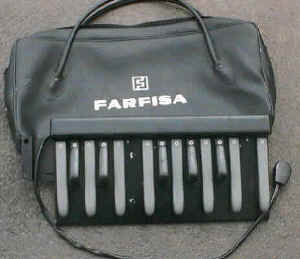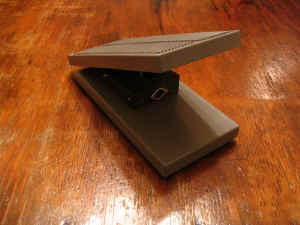|
FAST
2
Model
Name/Number:
C2/143=Compact FAST 2
Rather anemic, feature-wise, the FAST 2 is
nonetheless a pretty cool looking little fellow, all orange and dark blue-grey
body, with orange ball feet. It
sports a 4-octave keyboard, with 3 octaves dedicated to treble
voices and a 1-octave fixed bass section. There are only four treble voices, all 8'. The single-voice bass
octave is always-on, controlled only by the bass volume control.
The bass notes feed into the same voice filter as the Flute tab (but are
not switched on/off by that tab), and so have the same sound.
Thus, with only the Flute tab on, you get four full octaves of Flutes. The Bass keys, however, are monophonic, with low-note priority. It also has a built-in 10-watt
amp with two 6x9 speakers - an
unusual feature for one of the earlier Farfisas (some of the later VIPs
and Matadors had amps/speakers built-in).
The sound of the FAST 2 isn't as anemic as
you'd expect. It actually sounds pretty good, for being single-footage
voices. The four voices are noticeably different from one another, and mix
together well. One rather odd "feature" is that the lowest
5 notes in the Treble section are monophonic. For some odd reason, They
decided to save a buck (or two) by skimping on the lowest four dividers.
Note about the pictures below. These
are some really good pictures, which is why I chose them, but I don't believe
the two orange-topped knobs are original. The original knobs are grey with
a brass-color top.
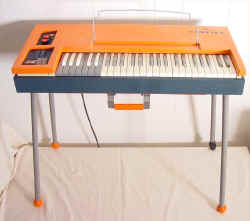  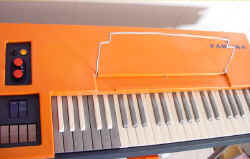
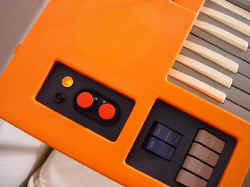 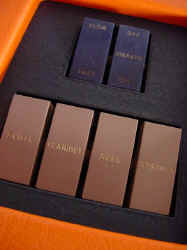
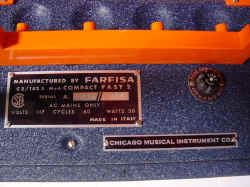 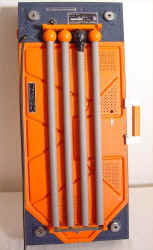 
Controls:
-
Voice
Tabs: Flute, Clarinet, Reed, Strings
-
Vibrato
Tabs:
Slow/Fast, Off/On
-
Knobs:
Volume, Manual
Bass Volume
|
|
FAST 2/C (or FAST 2/E?)
Model Name/Number: Compact FAST 2/C (or 2/E) Model
C2-E/144
A rather odd beast, what with its
largely wood grain appearance, and *almost* normal
colored keys (White naturals, Grey sharps/flats), it just doesn't seem to fit in with the
rest of the line, cosmetically. Still, the ID plate proudly proclaims
it as a member of the FAST line - so be it.
The FAST 2/C appeared in a flyer
with a 1969 date code, so it may have been introduced somewhat later
than the rest of the FAST series.
I'm sort of guessing at the first
part of the model number (above). The only good clear shot of an
ID badge I have is shown below, and the first part is cut off, but if it
follows with the others, it's likely a 'C'. As you can
see, one of these is a FAST 2/C, and the other a FAST 2/E, but
they look identical.
  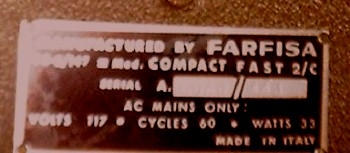
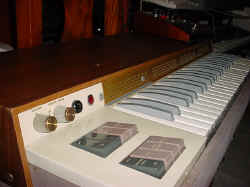 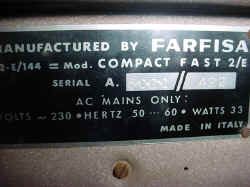
Micke Lindgren supplied the
following additional information: "I
have an original German leaflet for this model (FARFISA G.V. 69482) and
the organ pictured in there looks identical to the ones on your site
with the exception that it's sitting on a speaker/amp wood grain
cabinet, like a small spinet! Now, from what I understand it
actually came like this but if you wanted you could detach the organ
part from the cabinet to use as a portable organ (I can imagine though
that the ugly looking cabinets were discarded very quickly). The organ
has inputs for a swell pedal, an external amp, and a head-phone
connector."
Micke points out that the number,
69482, on the leaflet, may indicate it was released in 1969. The
Fast 2/C did appear in the May, 1970 price list, so that may well be the
case.
He also was able to translate the
description in the leaflet, and from that has surmised that the tabs
work as follows: The lighter grey voice tabs are for the treble
section. Only the dark grey tabs affect the bass section, which
comprises the first 17 keys. The 8'/16' selects either
footage for the bass section, "p/f" is a soft.loud switch, and
Manual Bass Off/On converts the bass section to extend the treble voices
across the keyboard. So that means with the bass section set for
bass, you've only got 2-1/2 octaves in the treble section!
Controls:
-
Upper row Tabs: 8'/16', p/f,
Flute 8', Clarinet 8'
-
Lower row Tabs: Manual Bass Off/On, Bass
16', Bass Clarinet 16', Bassoon 16'
-
Knobs: Volume,
Vibrato Speed
|
|
FAST
3
Another good looker, this
time with some significant improvements over the FAST 2. 7-voices in 3
footages, Bass section switchable to extend the treble section.
Model
Name/Number: I've seen four variations of the FAST 3. Following
are the model names/numbers as they appear on the ID plates:
-
Mod. C3/133=COMPACT
F.A.S.T. 3:
White/Green with chrome legs (Note the periods in the FAST name)
-
Mod. C3/133=COMPACT F
A S T 3:
White/Black with chrome legs, and "Fast 3" in script on
the back panel (and no periods)
-
Mod. MM/133: White/Green
with white legs
-
Mod. MM/132: White/Green
with chrome legs - I've only seen one of these. The legs appear
to be the only difference between it and the MM/133. (I don't have a decent
picture of one of these)
Here's the model C3/133 in White/Green
with chrome legs:
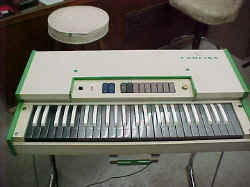 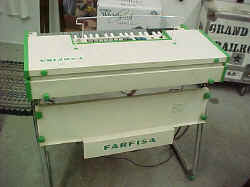 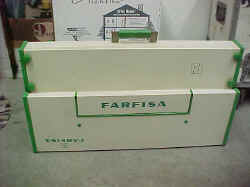
 
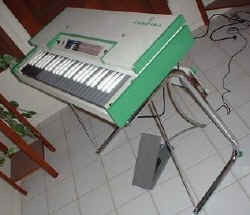  
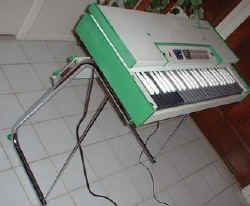 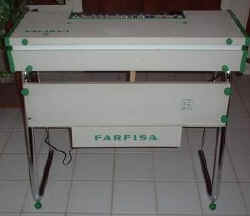
And here's pretty much the same model,
C3/133, but in White/Black. Note the script "Fast
3" on the back.
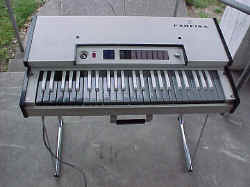 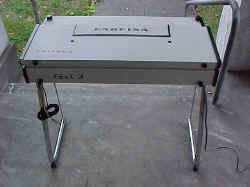 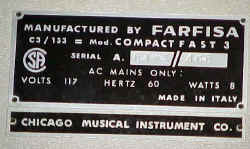
And here's the MM/133, looking just like
the White/Green C3/133, but with white legs instead of chrome.
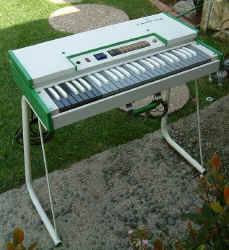 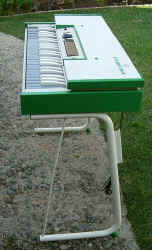 
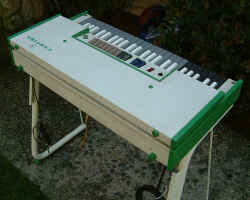 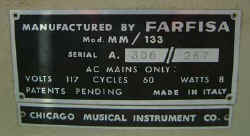 
Controls:
-
Vibrato Tabs (blue): Slow/Fast, Off/On
-
Bass
Tabs (black): Manual Bass Selector: Treble/Bass, p/f (Bass volume)
-
Voice
Tabs: Bass 16', Clarinet 16', Flute 8', Oboe 8', Trumpet 8', Strings 8',
Flute 4'
-
Knob:
Overall
volume
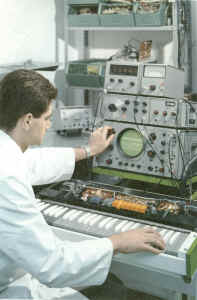 |
And here's an odd picture, from a
Fast-3 sales brochure. Note the voice tabs - they're Orange!
Every other one I've seen has had purple tabs, like all those shown
above Two other pictures from the same brochure (both with the top
removed) showed orange tabs, but other pictures in the same brochure
(all with the top on) had the purple tabs. Maybe when you remove
the top, the tabs turn orange? |
|
|
FAST
4
The
FAST 4 takes the FAST 3's features, and adds a few voices (Piccolo 4', Mixture,
Brilliant Mixture), Percussion (separately selectable for Bass, Treble and/or
Mixture voices), and a "Light/Heavy" switch for the
Vibrato.
Model
Name/Number: Mod.
C4/153=COMPACT FAST 4 - Some came with blue trim, and some with black.
Some have "Fast 4" in script on the back (and some don't).
From what I've seen, they all have the
same model name/number.
This is the only decent picture of a blue-trimmed FAST-4 that I
have:
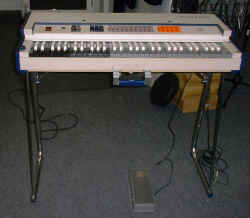
Here's an interesting effect. Move your mouse over the
picture below to remove the cover:
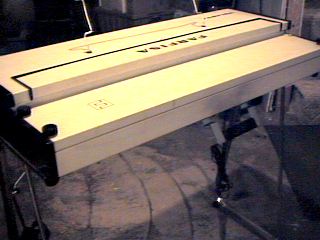
Here's a black-trimmed one showing the "Fast
4" lettering on the back:
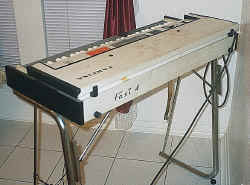
And some more pictures of the black-trimmed version
(without the "Fast 4" on the back)
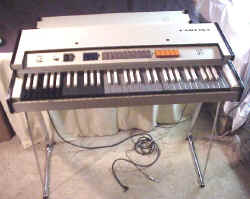 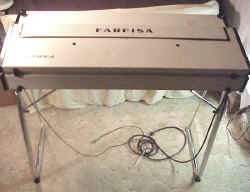
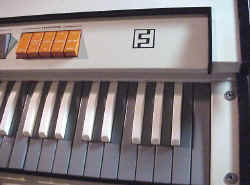 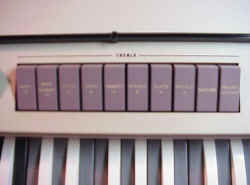

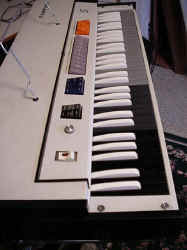 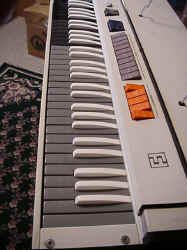 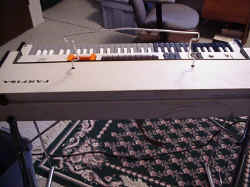
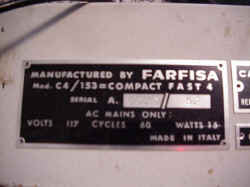 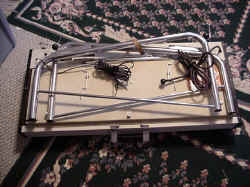
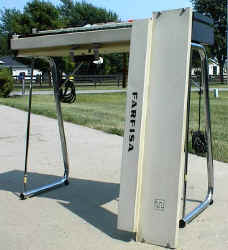 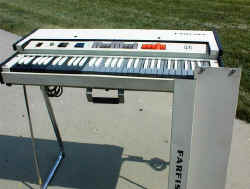 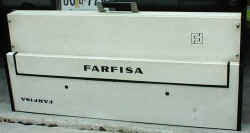
Controls:
-
Bass Tabs
(black): Pedal Bass Manual: Soft/Sharp, Manual Bass Selector:
Treble/Bass
-
Vibrato Tabs
(blue): Slow/Fast, Light/Heavy, Off/On
-
Treble
Voice Tabs (purple): Bass 16', Bass Clarinet 16', Flute 8', Oboe 8',
Trumpet 8', Strings 8', Flute 4', Piccolo 4', Mixture, Brilliant Mixture
-
Percussion
Tabs (orange): Manual Bass On/Off, Treble On/Off, Long/Short,
Mixture On/Off, Mixture Soft/Sharp
-
Knob:
Volume
|
|
FAST
5
Top-o-the-line, the FAST 5 improves on the
FAST 4 with the addition of three 8' Sustain
voices (Celesta, Clavichord, Kinura).
Model
Name/Number:
Mod. C5/163=Compact FAST 5
- I've only
seen them with black trim so far. Some have "Fast 5" in script on
back, and some don't. I also have seen one ID plate (shown below) with the
model# C5/162 - no apparent differences.
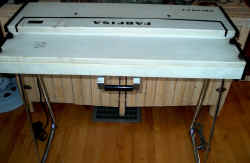 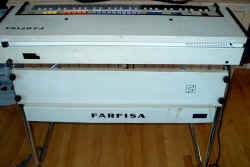
 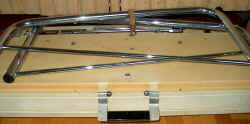
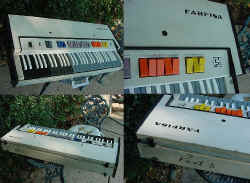 |
Here's one with the
"Fast 5" in script on the back. |
Controls:  (Click on the picture to enlarge)
(Click on the picture to enlarge)
-
Bass Tabs
(black): Pedal Bass Manual: Soft/Sharp, Manual Bass Selector:
Treble/Bass
-
Vibrato Tabs
(blue): Slow/Fast, Light/Heavy, Off/On
-
Treble
Voice Tabs (purple): Bass 16', Bass Clarinet 16', Flute 8', Oboe 8',
Trumpet 8', Strings 8', Flute 4', Piccolo 4', Mixture, Brilliant Mixture
-
Percussion
Tabs (orange): Manual Bass On/Off, Treble On/Off, Long/Short,
Mixture On/Off, Mixture Soft/Sharp
-
Sustain
Voice Tabs (yellow): Celesta 8', Clavichord 8', Kinura 8'
-
Knob:
Volume
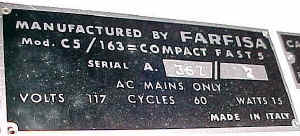 Typical ID plate, showing the typical model # C5/163. All but one I've
seen was like this.
Typical ID plate, showing the typical model # C5/163. All but one I've
seen was like this.
 Unusual specimen - Model# is C5/162. No apparent differences,
though. Weird.
Unusual specimen - Model# is C5/162. No apparent differences,
though. Weird.
Sound Samples! Farfisa
FAST 5 Demo - courtesy of elmacaco
|
